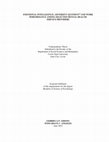Papers by Gerrieca Adiong

Emotional Intelligence, Adversity Quotient ® and Work Performance Among Selected Mental Health Service Providers
CVSU, 2019
The study in general aimed to know the relationship in emotional intelligence, adversity quotient... more The study in general aimed to know the relationship in emotional intelligence, adversity quotient and work performance among selected mental health service providers. This study is a quantitative research which involved collecting data from a total of 130 participants from various institutions of mental health service providers in their work setting. The participants were asked to complete the Scale of the Assessing Emotion Scale (AES), Adversity Quotient Profile® (AQP®) and Role-Based Performanc Scale (RBPS). The scales were used to determine the level of emotional intelligence, adversity quotient® and work performance of the respondents. Together with the test provided, the respondents were also asked to answer a short demographic profile sheet that also contains the informed consent form. The sampling technique used in this particular study was non-probability sampling where the samples were gathered in a process that does not give all the individuals in the population equal chances of being selected. Specifically, the study utilized purposive sampling and quota sampling in this study. Also, the researchers used descriptive and correlational research design. It is a descriptive study because the characteristics of the respondents such as demographic profile in terms of age, sex at birth, civil status, level of emotional intelligence, level of adversity quotient® and level of work performance were described. This study also aimed to determine the relationship among variables. Quantitative method of research was used in the study and several statistics were employed in the treatment of data gathered such as percentage, weighted men and Spearman’s Rank Correlation Coefficient. It was found that the overall emotional intelligence of mental health service providers were high while their overall adversity quotient were at low level. It was also found out that majority of the respondents were rated ‘good’ in their overall work performance evaluation based on their own, peer or supervisor rating. The findings of the study were as follows: There was no significant relationship between emotional intelligence and overall adversity quotient® among selected mental health service providers. The null hypothesis is accepted. However, there is a significant relationship between adversity quotient® and work performance among selected mental health service providers. The null hypothesis is rejected. Lastly, there is a significant relationship between emotional intelligence and work performance among selected mental health service providers. The null hypothesis is rejected.

CVSU, 2019
The study in general aimed to know the relationship in emotional intelligence, adversity quotient... more The study in general aimed to know the relationship in emotional intelligence, adversity quotient and work performance among selected mental health service providers. This study is a quantitative research which involved collecting data from a total of 130 participants from various institutions of mental health service providers in their work setting.
The participants were asked to complete the Scale of the Assessing Emotion Scale (AES), Adversity Quotient Profile® (AQP®) and Role-Based Performanc Scale (RBPS). The scales were used to determine the level of emotional intelligence, adversity quotient® and work performance of the respondents. Together with the test provided, the respondents were also asked to answer a short demographic profile sheet that also contains the informed consent form. The sampling technique used in this particular study was non-probability sampling where the samples were gathered in a process that does not give all the individuals in the population equal chances of being selected.
Specifically, the study utilized purposive sampling and quota sampling in this study. Also, the researchers used descriptive and correlational research design. It is a descriptive study because the characteristics of the respondents such as demographic profile in terms of age, sex at birth, civil status, level of emotional intelligence, level of adversity quotient® and level of work performance were described. This study also aimed to determine the relationship among variables. Quantitative method of research was used in the study and several statistics were employed in the treatment of data gathered such as percentage, weighted men and Spearman’s Rank Correlation Coefficient.
It was found that the overall emotional intelligence of mental health service providers were high while their overall adversity quotient were at low level. It was also found out that majority of the respondents were rated ‘good’ in their overall work performance evaluation based on their own, peer or supervisor rating.
The findings of the study were as follows: There was no significant relationship between emotional intelligence and overall adversity quotient® among selected mental health service providers. The null hypothesis is accepted. However, there is a significant relationship between adversity quotient® and work performance among selected mental health service providers. The null hypothesis is rejected. Lastly, there is a significant relationship between emotional intelligence and work performance among selected mental health service providers. The null hypothesis is rejected.










Uploads
Papers by Gerrieca Adiong
The participants were asked to complete the Scale of the Assessing Emotion Scale (AES), Adversity Quotient Profile® (AQP®) and Role-Based Performanc Scale (RBPS). The scales were used to determine the level of emotional intelligence, adversity quotient® and work performance of the respondents. Together with the test provided, the respondents were also asked to answer a short demographic profile sheet that also contains the informed consent form. The sampling technique used in this particular study was non-probability sampling where the samples were gathered in a process that does not give all the individuals in the population equal chances of being selected.
Specifically, the study utilized purposive sampling and quota sampling in this study. Also, the researchers used descriptive and correlational research design. It is a descriptive study because the characteristics of the respondents such as demographic profile in terms of age, sex at birth, civil status, level of emotional intelligence, level of adversity quotient® and level of work performance were described. This study also aimed to determine the relationship among variables. Quantitative method of research was used in the study and several statistics were employed in the treatment of data gathered such as percentage, weighted men and Spearman’s Rank Correlation Coefficient.
It was found that the overall emotional intelligence of mental health service providers were high while their overall adversity quotient were at low level. It was also found out that majority of the respondents were rated ‘good’ in their overall work performance evaluation based on their own, peer or supervisor rating.
The findings of the study were as follows: There was no significant relationship between emotional intelligence and overall adversity quotient® among selected mental health service providers. The null hypothesis is accepted. However, there is a significant relationship between adversity quotient® and work performance among selected mental health service providers. The null hypothesis is rejected. Lastly, there is a significant relationship between emotional intelligence and work performance among selected mental health service providers. The null hypothesis is rejected.
The participants were asked to complete the Scale of the Assessing Emotion Scale (AES), Adversity Quotient Profile® (AQP®) and Role-Based Performanc Scale (RBPS). The scales were used to determine the level of emotional intelligence, adversity quotient® and work performance of the respondents. Together with the test provided, the respondents were also asked to answer a short demographic profile sheet that also contains the informed consent form. The sampling technique used in this particular study was non-probability sampling where the samples were gathered in a process that does not give all the individuals in the population equal chances of being selected.
Specifically, the study utilized purposive sampling and quota sampling in this study. Also, the researchers used descriptive and correlational research design. It is a descriptive study because the characteristics of the respondents such as demographic profile in terms of age, sex at birth, civil status, level of emotional intelligence, level of adversity quotient® and level of work performance were described. This study also aimed to determine the relationship among variables. Quantitative method of research was used in the study and several statistics were employed in the treatment of data gathered such as percentage, weighted men and Spearman’s Rank Correlation Coefficient.
It was found that the overall emotional intelligence of mental health service providers were high while their overall adversity quotient were at low level. It was also found out that majority of the respondents were rated ‘good’ in their overall work performance evaluation based on their own, peer or supervisor rating.
The findings of the study were as follows: There was no significant relationship between emotional intelligence and overall adversity quotient® among selected mental health service providers. The null hypothesis is accepted. However, there is a significant relationship between adversity quotient® and work performance among selected mental health service providers. The null hypothesis is rejected. Lastly, there is a significant relationship between emotional intelligence and work performance among selected mental health service providers. The null hypothesis is rejected.